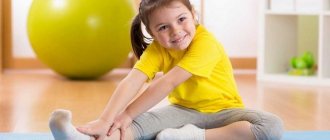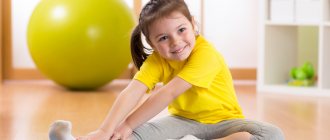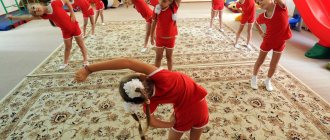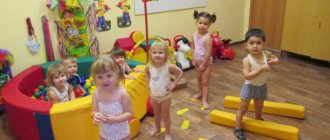Choosing the type of children's gymnastics
Health is unthinkable without movement. And if it is sometimes difficult for us to persuade ourselves to do exercises once again, then children are happy to do it themselves. Once a child starts walking, there is no stopping him. The baby continuously explores the world around him through sight, hearing, taste, smell and touch.
In the first months of life, the child is limited in movement and cognition. But the more varied the movements, the more varied the information obtained through them. So the mental development of a child directly depends on his physical activity.
The dependence here is very simple: a) sedentary muscles, bones, ligaments and joints do not receive enough stimulation, as a result of which b) they do not acquire the tone necessary for further growth, which c) slows down the development of motor skills and abilities, and this leads to d) limitation of capabilities learn new things about the world.
Fortunately, we have gymnastics - it will help eliminate the baby’s lack of movement and create favorable conditions for his health and development. Gymnastics will also help maintain emotional contact between mother and baby. Mom's loving hands, her gentle strokes, her gentle voice when she reads nursery rhymes to the baby during classes - all this makes the baby very happy.
Infants can only participate in passive exercise programs. This:
1) gymnastics (physical exercises);
2) gymnastics on the ball;
3) aqua gymnastics.
You can read about massage, which is also considered a type of passive gymnastics, at this link. And here we will talk about why each of the listed types of gymnastics is interesting and useful.
Gymnastics is good for a wide variety of movements. Exercise improves appetite, digestion, sleep, deepens breathing (thereby developing the lungs), causes increased blood flow to the muscles, to the bones with which they are connected, which promotes their growth. They tone the body and give the baby a great boost of energy and joy. The baby learns to feel his body, understand its signals and be in harmony with his physical self.
Up to a year, it is advisable to precede gymnastics with your baby with a massage session. It warms up and prepares the muscles for stress during physical exercise, which will be the final stage of the massage.
Movement is life! And great joy
We talked about the importance of physical activity in the first year of a child’s life and found out that gymnastics can minimize the negative consequences of movement deficiency in an infant. Movement is directly related to mental development at this age, since the baby receives basic information about the world through sensory channels of perception. Gymnastics in all its diversity gives impetus to the enrichment and expansion of these channels. And the more opportunities a child has to learn, the more complete the picture of the world is formed in his mind and the more successfully he will cope with the tasks that life will set for him.
No matter how you work out with your baby, no matter what type of gymnastics you choose for yourself, the main thing is that you remember why you started working out with your child. If there are indications for therapeutic massage, you should entrust the matter to the hands of a professional. If they are not there and you decide to practice at home, then this is because you want your baby to be healthy and happy.
Let home gymnastics be not only and not so much a good physical workout for your child, but a way to live wonderful moments of harmony, mutual understanding and quiet joy with your baby. We wish you and your baby health!
Article on our Yandex Zen channel
Basic principles of aqua gymnastics
- Comfortable water temperature in the first lessons is 37 - 37.5 degrees, with a decrease in it by 3 degrees until the end of the first month of swimming, and another 2 degrees in the third. For those who are bolder: please remember that the temperature should not fall below 28 degrees - in this case we are talking about hardening.
- The air temperature in the bathroom is 20 - 22 degrees, the door is open. Classes are held 40–60 minutes after feeding and 30 minutes before it.
- Duration of classes - 5 - 20 minutes.
- Water should be without additives (potassium permanganate, essential oils, herbal decoctions, salt), since baths with these additives are therapeutic and are designed for a lying baby, and aqua gymnastics is a set of active exercises with a fairly intense load on the muscles, respiratory, and cardiovascular systems.
- During exercises in water, the baby's ears may become submerged in water; after exercise, do not forget to dry them.
- The duration of classes in water for babies under 4 months in addition to a general massage is about 5 minutes, for older children - up to 10 minutes.
- As an independent type of exercise, aqua gymnastics is carried out for 15 – 20 minutes.
- Contraindications are: open umbilical wound, skin diseases, poor health and mood of the child, acute respiratory viral and other infections in the active phase (exacerbations), acute period of encephalopathy, rapid increase in intracranial hypertension, convulsions, extreme prematurity of children (rapid cooling) and general contraindications related to the purpose of gymnastics and massage.
Aqua gymnastics
Children are very accepting of this relatively new method of physical development. You can start exercises at home, in the bathroom and make them the final stage after massage and gymnastics or a separate lesson.
Swimming from the first months of a child’s life is very useful not only for physical development, but also for strengthening the nervous system. The baby is immersed in an environment to which he is accustomed, and this gives him a feeling of psychological comfort. Exercises in water do not overload the child and are especially recommended for children with psychomotor development disorders or diseases of the musculoskeletal and nervous systems.
Swimming:
- strengthens the immune system;
- normalizes sleep;
- regulates metabolism;
- stimulates the gastrointestinal tract;
- saturates the blood with oxygen;
- trains the cardiovascular system;
- forms correct breathing;
- affects the nervous system.
The main thing in classes is their gradualness and systematicity. While the baby gets used to the procedure, you can be in the bathroom with him; usually both the adult and the baby get great pleasure from this.
Gymnastics on the ball
Children of any age really enjoy exercises on the ball. But in infancy, in addition to the pleasure of activities, we can safely talk about their undoubted benefits.
- Reduce muscle hypertonicity;
- Improve the functioning of internal organs;
- Train the vestibular apparatus;
- Strengthens the muscles of the back, abdomen and limbs;
- Reduce discomfort during colic.
A set of exercises for children helps strengthen the back muscles, especially around the spine, making the spine strong and flexible. And this is the key to the normal functioning of the nervous system and the free distribution of nerve impulses throughout the body.
Basic principles of ball gymnastics
- Strengthening the back muscles - place the child on his stomach.
- Strengthening the abdominal muscles - place the child on his back.
- Strengthening muscles during an umbilical hernia - we place the child on his back.
- General relaxation of the child - usually on the stomach.
- Correction of muscles in case of asymmetry of muscle tone - tilting the ball in the direction where increased tone is observed.
The optimal diameter of the ball for practicing with an infant is 60–65 cm. In infants, in order to reduce increased tone, the ball is lowered slightly; in order, on the contrary, to tone the body, they inflate it tightly. Apart from those common to all types of gymnastics, there are practically no specific contraindications for exercising on a ball, with the exception of an unhealed umbilical wound. You can start classes as early as one month of age.
Don’t worry if at first both you and your baby feel a little unsure and tense: you both will quickly get used to it if you practice regularly and without forcing things.
You will be surprised how quickly your baby’s body will react to such activities: the results of exercises on the ball will be noticeable almost immediately. The baby will become more active, stronger, will no longer be afraid of changes in the position of his body, his sleep and appetite will improve, and he will receive a positive emotional charge.
Other types of children's gymnastics
So you have become acquainted with the most reliable and proven methods. However, there are several other types of gymnastics that parents may be familiar with: baby yoga, dynamic gymnastics and mom yoga.
In the first case, we are talking about the manual practice of getting rid of possible birth injuries in the first two weeks after the birth of a child, which is carried out only by a highly qualified specialist. The second is a set of acrobatic exercises aimed at correcting muscle tone and developing coordination and the vestibular apparatus; training takes place in special classes with an instructor. In the third case, we are talking about mother’s yoga classes in the presence of the baby with a small number of asanas, in which the baby can participate without experiencing any physical activity, but simply maintaining contact with the mother.
Thus, all these types of gymnastics cannot be done at home without preparation. If you are interested in these types of physical activity and are determined to try them, first consult with a pediatrician, neurologist and orthopedic surgeon, weigh the pros and cons, and take training from a certified instructor.







